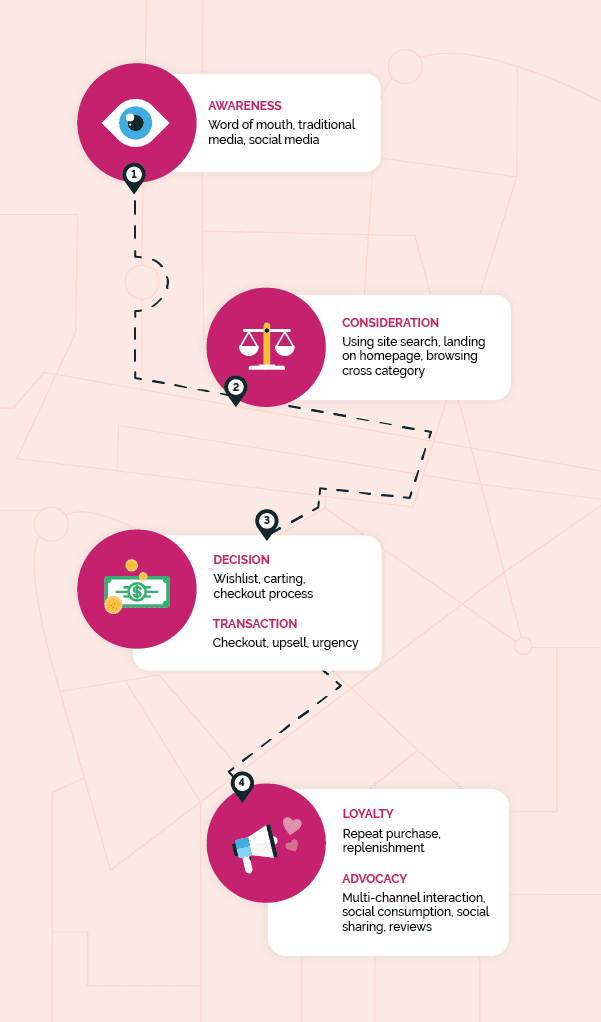If you’ve been reading our CRO blog series from the beginning, you’ve probably already implemented our 5 eCommerce conversion rate optimization tactics and you’re using our 5 A/B tests to take your conversion rate optimization efforts to the next level.
Now, we’re going to shine the spotlight on the most important component of any good CRO strategy – the customer. In this installment of our CRO blog series, we take a look at customer journey mapping for eCommerce stores, explaining what it is and why it’s important.
There’s lots to discuss, so let’s get cracking.
The age of customer experience
It goes without saying that conversion rate optimization is so much more than just optimizing the checkout page. But the importance of optimizing the entire customer experience cannot be overstated. Research shows that 80% of customers now consider their experience with a company to be as important as its product.
What’s more, 60% of customers in the UK expect the customer experience to be connected. And with the average consumer using 10 channels to communicate with businesses, customer journeys are becoming increasingly complex.
So, with several touchpoints increasing the danger of a disjointed customer journey, how can eCommerce businesses ensure they deliver the tailored, seamless experience their shoppers want?
That’s where customer journey mapping comes in.
What is customer journey mapping?
Customer journey mapping is the process of identifying the interactions that customers experience throughout their relationship with your online store, plotting them out into a logical order and optimizing them continuously.
Why is making an eCommerce customer journey map important?
The customer is at the heart of every successful conversion rate optimization strategy. The word strategy is key here, as conversion rate optimization isn’t about guessing what the customer wants and hoping your assumption is right. Through the process of making your eCommerce customer journey map, businesses can get strategic about understanding customer expectations, identifying pain points and optimizing the experience of your customers for maximum conversions.
Making an eCommerce customer journey map helps businesses look beyond customer experience as a summary of all interactions and touchpoints and instead consider how to display empathy towards customers at all the customer journey stages. Interbrand talks about the empathy gap that exists between brands and their customers, where brands get so caught up with what they want to say, they look past what people need to hear and how they need to hear it. According to Interbrand, this empathy gap is widening, making customer journey mapping a key opportunity for retailers and brands to distinguish themselves from the competition.
For anyone in need of hard evidence, here are some compelling stats on companies that actively manage the customer journey vs those who don’t:
- They get 54% greater return on marketing investment
- Their average sales cycles are 18 times faster
- They get 56% more cross- and up-sell revenue from their existing customers
(Source: Aberdeen Group)
Put simply, businesses that focus on their customer’s journey and customer’s experience outperform their peers.
Getting started
Now that you know what customer journey mapping is and why it’s important for conversion rate optimization, it’s time to start mapping out your own customer journey. Keep it simple to start with, plotting key interactions and touchpoints along the journey stages. Once you have the bare bones of your customer journey map, you’re ready to create variations for each of your buyer personas.
Here is an example of a basic eCommerce customer journey map for retail:

Let’s look at this example in more detail.
Consideration
It’s important to empathize with your customers’ goals at each stage of the journey. Once potential customers have landed on your homepage, they enter the consideration stage and their goal is to find the best solution or product for them. To do this, it’s likely that they will use the navigation bar and site search function to browse across different product categories.
Decision & Transaction
At this stage of the customer journey, the shopper’s goal is to be inspired, find products easily and order effortlessly. They might make use of wishlist functionality to save items that have caught their eye. And in order to make a purchase, they’ll need to follow the checkout process.
Loyalty & Advocacy
Once a customer has made their purchase, their goal will be to repeat the (hopefully) good customer experience and become one of your loyal customers. They might also want to show their affiliation with the brand by sharing user generated content or taking part in a referral program. Additionally, they might be keen to give product feedback in the form of a review or rating. The touchpoints here will be post-purchase emails, such as review requests and replenishment notifications, as well as social media channels.
eCommerce customer journey maps a vital part of any good eCommerce conversion rate optimization strategy, helping businesses understand their customers, identify pain points and deliver a customer experience that boosts sales. If you’re not already mapping your customer journey or haven’t revisited your customer journey map in a while, use our example above to get started.
Keep your eyes peeled for the next installment of our CRO blog series, where we’ll be sharing our tips to help you reduce friction in the journey.
In the meantime, download The Ultimate Ecommerce CRO Lookbook and learn how to optimize your customer journey with personalization examples from 21 leading brands.



![Download The Ultimate Ecommerce CRO Lookbook [new visitors edition]](https://no-cache.hubspot.com/cta/default/483487/fae6a964-e7c6-4987-82c1-127ae37699eb.png)



